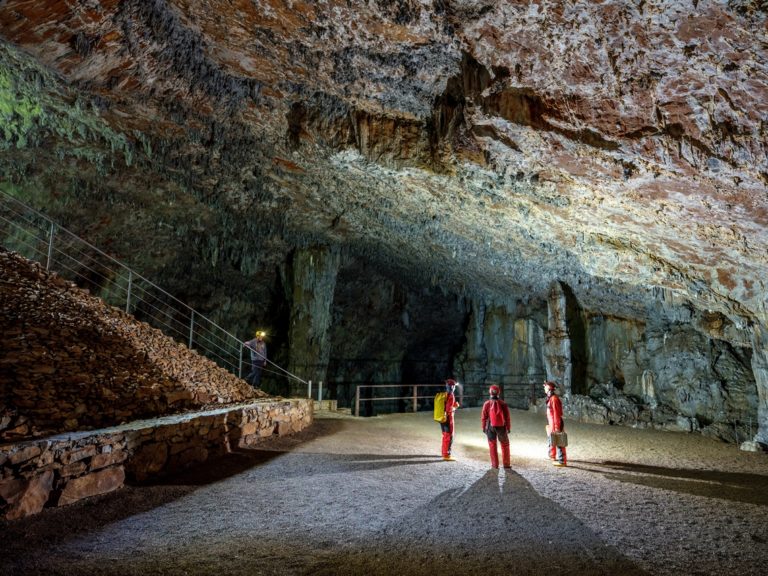
FUN FACTS
VILENICA – THE FIRST SHOW CAVE IN THE WORLD: The Vilenica Cave is the first show cave in the world. Tours have been held since as far as 1633.
NOTABLE VISITORS: The first visitor of note was Leopold I, Holy Roman Emperor, who visited the Lipica Stud Farm and then the Vilenica Cave in 1660. However, he was not the only royal to visit the cave: Ferdinand I, king of the Two Sicilies (1790), Leopold II, Holy Roman Emperor, Archduke of Austria (1790 and 1791), Francis I, the Emperor of Austria (1816 and 1818), and Frederick Augustus II of Saxony (1836) all visited the cave. Another visitor of note was the natural scientist Balthazar Hacquet, who also visited the cave in 18th century.
THE FIRST VISITOR’S BOOK: The visitor’s book was introduced in 1821. Today it is kept at the Karst Research Institute (ZRC SAZU) in Postojna. By 1889 already more than 2000 domestic and foreign visitors were recorded in it.
POETIC INSPIRATION: The Venetian Giuseppe Campagnioni was so inspired by the diversity and colorfulness of the dripstones in the cave that he wrote an epic poem about the Vilenica Cave and dedicated it to his betrothed Aspasia.
POSITIVE ENERGY LINE IN FRONT OF THE VILENICA CAVE: The artist Marko Pogačnik, a student of geomancy, chiseled cosmograms that represent the human connection to the subterranean world into stone pillars from the Lipica quarry and erected them in front of the Vilenica Cave. A dragon line (positive energy line) also passes the cave.
LIPICA STUD FARM: The Lipica Stud Farm is the home of the Lipizzan horses, one of the oldest breeds of horses. The stud farm history traces back to the 16th Century (founded in 1580). From that period onward, all landscaping was greatly influenced by the main objective – breeding the Lipizzan horses.
SEŽANA BOTANICAL GARDEN: The origins of the garden date back to 1848 when Giovanni Scaramnagà di Hiccolo Cavaliere from Trieste started planting it next to his villa Mirasasso (admirer of the stone). He was a botanical enthusiast and grew plants from several parts of the world, many of them you can still see today while strolling through the garden.
TABOR LOKEV MILITARY MUSEUM: The Lokev Military Museum is located in a defense tower named Tabor built in 1485. Visitors can acquaint themselves with World War I and World War II through the exhibited collection of uniforms with the corresponding equipment and weaponry. “Tabor” is also a Slovene word for a medieval fortification, which was often built around churches.
KOSOVEL’S HOMESTEAD, TOMAJ: The Kosovel’s Homestead is in the village of Tomaj. It is where the Slovenian poet Srečko Kosovel (1904-1926) spent a part of his youth. Today, partially preserved personal belongings of the poet as well as the household goods belonging to the Kosovel family are exhibited here.
ŠTANJEL: The village Štanjel is one of the oldest settlements in the Karst Region famous for its old village center. Most of the distinctive architectural elements of the buildings originate in 16th and 17th centuries when the settlement was at its peak of development. The architect Max Fabiani also left his mark on the settlement’s architecture in the years between the two World Wars.
MUSEUM OF SLOVENIAN FILM ACTORS, DIVAČA: The museum is situated in the Škratelj Homestead, the birthplace of the Slovenian actress Ida Kravanja – Ita Rina (1907-1979). The museum houses two exhibits; one dedicated to Ita Rina and another to all Slovenian film actors.
PARK ŠKOCJANSKE JAME: The Škocjan Caves are a cave system listed by UNESCO as a World Heritage Site because of their natural and cultural significance. The cave system consists of the Reka River sinkhole, collapse dolines, underground chambers, and an underground canyon of large dimensions.
DIVAŠKA CAVE: The Divaška Cave is located between Divača and Lokev. It is 700 m long and 500 m of it is open for visitors.
KARST LIVING MUSEUM: A hidden wonder of nature and a treasure trove of karstic phenomena like the sinkholes, uvalas, collapse dolines, karren, abysses, and of course underground caves spreads over 700 hectares between Sežana, Lipica, and the former Slovenia-Italy border along the old Austro-Hungarian road representing the natural and cultural heritage of the typical Karst. There are themed walks, cross-border recreational trails, and marked points of interest within the museum. The whole area represents the so-called Classical Karst packed with karst phenomena, numerous protected natural values, and protected natural areas.




